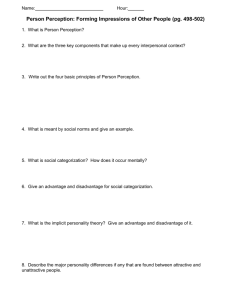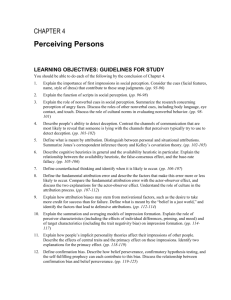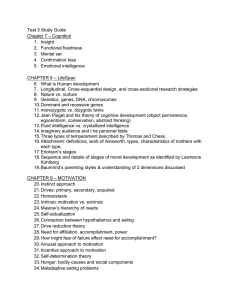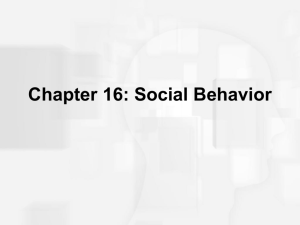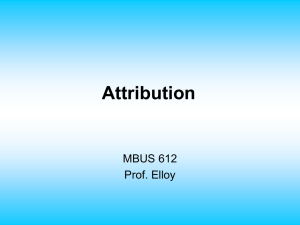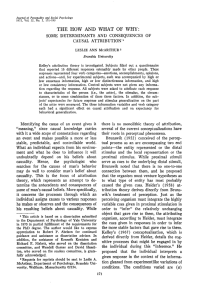BA 352 lecture ch4
advertisement
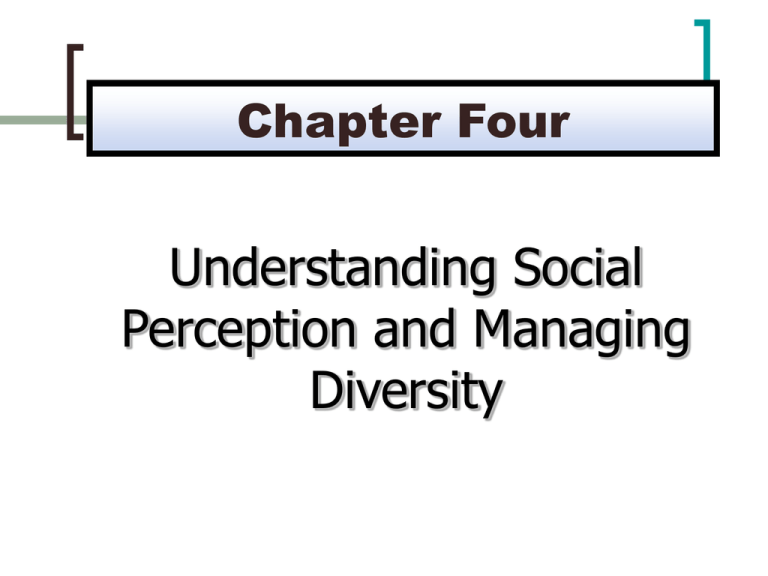
Chapter Four Understanding Social Perception and Managing Diversity 4-1a Chapter Four Outline A Social Information Processing Model of Perception •Stage 1: Selective Attention/Comprehension •Stage 2: Encoding and Simplification •Stage 3: Storage and Retention •Stage 4: Retrieval and Response •Managerial Implications Causal Attributions •Kelley’s Model of Attribution •Attributional Tendencies 4-1b Chapter Four Outline (continued) Defining and Documenting Diversity • • • Layers of Diversity Affirmative Action and Managing Diversity Increasing Diversity in the Workforce Organizational Practices Used to Effectively Manage Diversity • • Barriers and Challenges to Managing Diversity Ann Morrison Identifies Specific Diversity Initiatives 4-2a Figure 4-1a Social Perception: A Social Information Processing Model Stage 1 Selective Attention/ Comprehension Competing environmental stimuli: * People * Events * Objects Stage 2 Encoding and Simplification A B C D E F A Interpretation and categorization C F 4-2b Figure 4-1b Social Perception: A Social Information Processing Model (continued) Stage 3 Stage 4 Storage and Retention Memory Retrieval and Response C Judgments and decisions 4-3a Social Information Processing Model of Perception Stage 1: Selective Attention/Comprehension - Attention is the process of becoming aware of something or someone - People pay attention to salient stimuli Stage 2: Encoding and Simplification - Encoding is the process of interpreting environmental stimuli by using information contained in cognitive categories and schemata - The same information can be interpreted differently by people due to individual differences 4-3b Social Information Processing Model of Perception (continued) Stage 3: Storage and Retention - Encoded information or stimuli is sent to longterm memory - Long-term memory is composed of three compartments containing categories of information about events, semantic materials, and people Stage 4: Retrieval and Response - Information is retrieved from memory when people make judgments and decisions 4-4 Stereotypes A stereotype is an individual’s set of beliefs about the characteristics of a group of people. 4-5 Table 4-1 • Common Perceptual Errors Halo: A rater forms an overall impression about an object and then uses the impression to bias ratings about the object. • Leniency: A personal characteristic that leads an individual to consistently evaluate other people or objects in an extremely positive fashion. • Central Tendency: The tendency to avoid all extreme judgments and rate people and objects as average or neutral. • Recency Effects: The tendency to remember recent information. If the recent information is negative, the person or object is evaluated negatively. • Contrast Effects: The tendency to evaluate people or objects by comparing them with characteristics of recently observed people or objects. 4-6a Model and Example of Attribution Process Causal Attributions: Suspected or inferred causes of someone’s behavior. General Model of Attribution Process A behavior is observed Antecedent Attribution People consider the antecedents of the behavior - Why did the behavior occur? People determine the causes of behavior - This represents an attribution Consequence Attributions affect our subsequent behavior and expectations about people 4-6b Model and Example of Attribution Process (continued) Attribution Example Antecedent An employee turns in a report that contains many errors - This employee never did this before. - The employee is going through a bad divorce. - This employee is not motivated. Attribution The poor performance was due to personal issues outside of work. Consequence I will go talk to employee and offer support and coaching. 4-7a Kelley’s Model of Attribution Basic Premise: An attribution is based on the consensus, distinctiveness, and consistency of the observed behavior. Consensus - Involves comparing an individual’s behavior with that of his or her peers. - High consistency indicates an individual is different from peers. Distinctiveness - Involves comparing a person’s behavior or accomplishments on one task with the behavior or accomplishments from other tasks. - Highly distinctive behavior or results represents a situation where the current behavior or result is significantly different from typical behavior or results on other tasks. 4-7b Kelley’s Model of Attribution (continued) Consistency - Involves comparing a person’s behavior or accomplishments on a given task over time. - High consistency implies that a person performs a certain task the same, time after time. Predictions - Internal or personal attributions are made when a behavior is associated with low consensus and distinctiveness, and high consistency. - External or environmental attributions are made when a behavior is related with high consensus and distinctiveness, and low consistency. 4-8a Figure 4-2a Consensus Low A B C D People High E A B C D People Source: KA Brown, “Explaining Group Poor Performance: an Attributional Analysis,” Academy of Management Review, January 1984, p 56. Used with permission. E 4-8b Figure 4-2b Distinctiveness High Low A B C Tasks D E A B C Tasks D E Source: KA Brown, “Explaining Group Poor Performance: an Attributional Analysis,” Academy of Management Review, January 1984, p 56. Used with permission. 4-8c Figure 4-2c Consistency Low High Time Time Source: KA Brown, “Explaining Group Poor Performance: an Attributional Analysis,” Academy of Management Review, January 1984, p. 56. Used with permission. 4-9 Figure 4-3 The Four Layers of Diversity Functional Level/ Classification Geographic Location Mgmt. Status Marital Status Parental Status Age Income Work Content/ Field Personal Habits Race Personality Appearance Union Affiliation Sexual Orientation Ethnicity Work Experience Work Location Physical Ability Recreational Habits Division/ Dept./ Unit/ Group Religion Educational Background Seniority Source: L Gardenswartz and A Rowe, Diverse Teams at Work: Capitalizing on the Power of Diversity (New York: McGraw-Hill, 1994), p. 33 4-12 Barriers and Challenges to Managing Diversity Inaccurate stereotypes and prejudice Ethnocentrism Poor career planning Unsupportive and hostile work environment Lack of political savvy by diverse workers Balancing career and family issues Fears of reverse discrimination Diversity not seen as a priority Outdated performance appraisal and reward systems Resistance to change 4-13 Specific Diversity Initiatives Table 4-3 Accountability Practices Development Practices - Pertain to preparing diverse employees for greater responsibility and advancement - Training programs, networks and support groups, and mentoring are frequently used Recruitment Practices - Pertain to attracting qualified diverse employees at all levels - Pertain to treating diverse employees fairly - Create administrative procedures aimed at integrating diverse employees into management ranks
